| Tips | ||||||||||||||||||||||||||||||||||||||||||||||||||||||||||||||||||||||||||||||||||||||||||||||||||
| Here are some tips for foreign pilots who wish to fly for leisure in Thailand. They are based on my own experiences (dated 2013-2024). An "operator" may be a flying club, a flight school or any owner of aircraft(s). The "CAAT" is the Civil Aviation Authority of Thailand, which is responsible for licensing. | ||||||||||||||||||||||||||||||||||||||||||||||||||||||||||||||||||||||||||||||||||||||||||||||||||
| Flying in Thailand Compared to most Asian countries, flying small private aircrafts in Thailand is pretty liberal and they are many beautiful places in Thailand: mountains, jungles, seas, islands etc. Weather is mostly good, however during the rainy seasons it can get stormy. And of course, it's mostly really hot! During the colder winter months the visibility can be quite low. The airports mostly have long runways. But always make sure those airports are licensed and you have permission to land before you get there. Many of the procedures in Thailand differ highly from other countries. You may want to have familiarization lessons before you go solo. You should always need to be in contact with an ATSU, even if flying VFR in Airspace G. Basic IFR knowledge will be helpful to cooperate with ATC. Aircraft rental prices are between THB 4500 and THB 15000 per hour. Instructors cost THB 500 - THB 1500 per hour. Landing fees vary from free on smaller airfields up to extravagant on airline owned or big airports. |
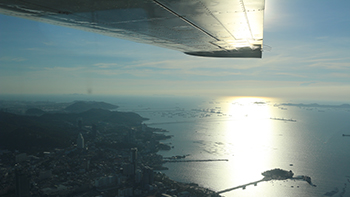 Sri Racha city. |
|||||||||||||||||||||||||||||||||||||||||||||||||||||||||||||||||||||||||||||||||||||||||||||||||
| Thai PPL license Both, Thais and foreigners are eligible to possess a Thai PPL license issued by the CAAT. A PPL course in Thailand costs between THB 400000 and THB 600000 and will lead you to a CAAT license valid for Thai registered aircrafts only. |
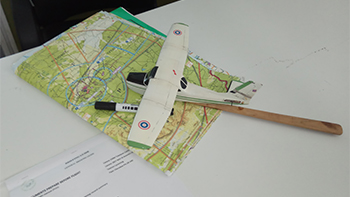 Flight school in Thailand. |
|||||||||||||||||||||||||||||||||||||||||||||||||||||||||||||||||||||||||||||||||||||||||||||||||
| Foreign PPL license validation To be able to privately fly Thai HS-registered aircrafts as PIC in Thailand without a full Thai license, you need to have your foreign license validated by the CAAT via an operator. However, you don't need to do a separate Medical Certificate in Thailand. The validation can't be done on your own, here are the steps to take: 1. Make sure all your licenses, ratings, medical and eventual English language proficiency (min. level 4 required) are still valid and you logged 3 hours of flight time within the last 90 days (outside of Thailand). 2. Find an operator that will get your foreign license validated and send them the documents they need. Remember a "certified copy" is a copy that is signed by you. 3. You need to pass the Thai Air Law examination at the CAAT headquarters in Bangkok, so arrange your next Thailand trip accordingly. 4. Pass the Thai Air Law examination. 5. After having received your validation, you will be allowed to operate as PIC immediately. However you may need or wish familiarization lessons. Normally the operator will charge you a certain fee that covers the CAAT examination fee, CAAT validation fee, their drive costs to the CAAT, etc. (approx. THB 2000 - THB 4000). You may also need to pay a membership fee to the operator before you fly. Normally no deposits are required. Important note: the validation will only be valid for the HS-registered aircraft(s) of one operator only. You will need separate validations if you wish to fly HS-registered aircrafts from other operators. Validations renewals and separate validations for other operators take around one month. |
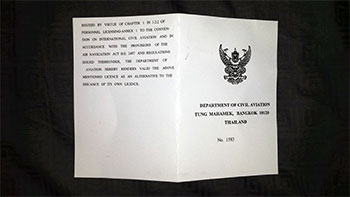 Foreign license validation document. |
|||||||||||||||||||||||||||||||||||||||||||||||||||||||||||||||||||||||||||||||||||||||||||||||||
| Flight preparation and information Thai AIP: You can order or print/download it from the CAAT website. The charts are mostly IFR, however there are some VFR procedure charts for some airports. Airport ground charts are included for all listed airports. Amendments are normally released monthly. VFR navigation charts: there are no official VFR flight navigation charts for Thailand. The best charts are the ones available on this site. Aerodrome charts: get the Thai AIP or the ones from Jeppesen. Flight plans: depending on your departure airport they need to be filed by phone, fax or other devices (not in the air!). Make sure they really were filed by re-confirming! The flight plans are not always "opened" and "closed", but just filed. NOTAM: NOTAM search (ICAO-code for Thailand FIR is "VTBB"). Weather briefing: METAR/TAF of the major airports, SWCs, satellite pictures, Thai miliary radar, Windy or weather apps. |
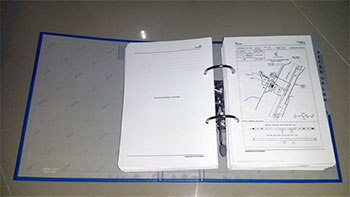 Self printed Thai AIP. |
|||||||||||||||||||||||||||||||||||||||||||||||||||||||||||||||||||||||||||||||||||||||||||||||||
| Thai Air Law and rules Thailand's Air Law is relatively uncomplicated and the document didn't change since 1953. It's only 88 pages thick and available online. To avoid high penalties and in order not to damage the reputation of private leisure flying in Thailand, take following rules seriously: - Don't ever fly without valid documents. - Don't ever fly without filed flight plans. - Don't ever fly in prohibited areas. - Don't ever fly in airspaces reserved for Royal or VIP flights. - Don't ever enter controlled airspaces without clearances. - Don't ever land outside aerodromes or on an aerodrome that isn't licensed. - Always maintain radio contact with the appropriate ATSU. - Always fully complete the necessary paperwork. |
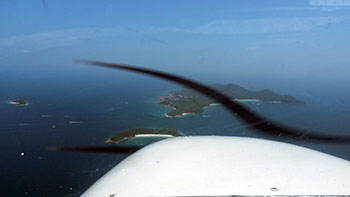 Flying over the gulf of Thailand. |
|||||||||||||||||||||||||||||||||||||||||||||||||||||||||||||||||||||||||||||||||||||||||||||||||